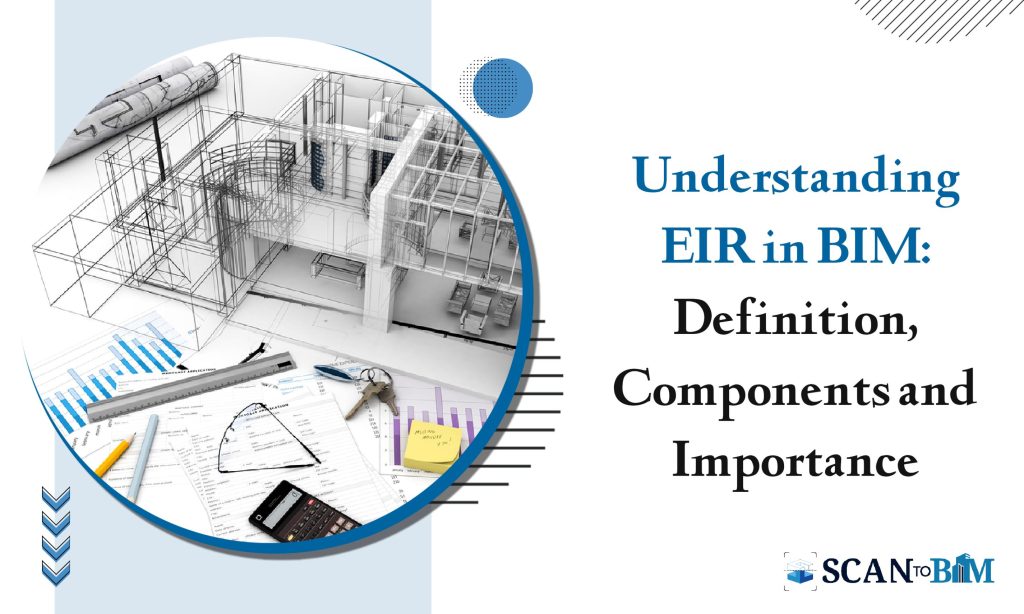
The BIM methodology is built on a collaborative workflow that facilitates the creation of the intelligent information models, integrating both the graphical and non-graphical data to comprehensively define all elements throughout the project lifecycle. These models serves as a centralized source of the structured information thereby ensuring the consistency, accuracy and interoperability across all the project phases.
A crucial aspect of this structured approach is the Exchange Information Requirements (EIR) which is a document that establishes the framework for the information management within a BIM project. It is defined by the client at the project’s inception and it specifies all the minute details ensuring the alignment with the project goals.
The EIR acts as a foundation for the effective collaboration and decision-making by clearly outlining what information is necessary, how it should be structured as well as when it should be delivered.
Let’s take a closer look as to what the EIR entails and why are they essential for the successful execution of the BIM projects.
What is an Exchange Information Requirements (EIR)?
An EIR document is a key component in the BIM projects outlining the information that needs to be exchanged between stakeholders throughout the project’s lifecycle. It defines the standards, formats, responsibilities along with the deliverables required to ensure the smooth communication and data consistency across all the project phases.
The EIR is typically developed by the client or the employer and sets the base for the information management thereby ensuring that the right data is provided at the right time to support the decision-making as well as the project execution. Many Scan to BIM Company rely on a well-defined EIR to facilitate the efficient project coordination and data management.
Why is an EIR Important in BIM?
- Clear Communication: It establishes a structured approach to the information exchange hence reducing the misunderstandings among the project stakeholders.
- Standardization: It ensures consistency in the data formats thereby reducing the risks of any of the incompatible information.
- Efficient Collaboration: It helps the teams to work cohesively by defining the roles, responsibilities as well as the deliverables.
- Compliance & Quality Control: It aligns well with the BIM standards such as ISO 19650 improving the project governance and the data integrity.
- Cost & Time Management: It reduces inefficiencies by ensuring that the accurate information is available when needed thereby preventing the costly rework.
What Should an EIR Include?
The EIR is structured around various components that contributes to its development. These components defines the necessary information for the project’s success and includes:
- Organizational Information Requirements (OIR): It outlines the overarching objectives of the client or stakeholder ensuring the alignment with the business and operational goals.
- Asset Information Requirements (AIR): It specifies the management aspects and also the technical procedures needed for the efficient operation as well as the maintenance of the built asset.
- Project Information Requirements (PIR): It includes the specific information required to implement and achieve the objectives for a particular project.
To fully integrate the EIR within a BIM framework, refer to the ISO 19650-1 which establishes the flow along with the hierarchy of information requirements in a structured BIM process.
Additionally, the following models completes the information management cycle:
- Project Information Model (PIM): It contains the design and construction-related data supporting the project planning and execution.
- Asset Information Model (AIM): It encompasses the data required for the use, management and even for the long-term maintenance of the built asset.
Key Components of an EIR
An EIR typically consists of three primary sections:
- Technical Requirements:
- File formats (e.g., IFC, RVT, DWG)
- Level of Information Needed (LOD, LOI, LOM)
- Data exchange protocols and workflows
- Software and tools compatibility
- Managerial Requirements:
- Roles and responsibilities of stakeholders
- Coordination and collaboration processes
- Data security and compliance measures
- Project milestones and submission deadlines
- Commercial Requirements:
- Contractual obligations for BIM deliverables
- Ownership and intellectual property rights
- Cost implications and resource allocation
- Procurement and supply chain requirements
How is an EIR Implemented in BIM Workflows?
- Client Definition: The client defines the project objectives and data needs, setting the expectations for BIM deliverables.
- Development & Review: The EIR is created, reviewed and refined with input from key stakeholders thereby ensuring the feasibility.
- Integration into BEP (BIM Execution Plan): The EIR is incorporated into the BEP guiding the project workflows and collaboration.
- Ongoing Compliance Monitoring: Throughout the project, adherence to the EIR guidelines is monitored with periodic assessments for the necessary updates.
- Final Handover: At project completion, the information is verified against the EIR to ensure the data accuracy and completeness.
What Sets an EIR Apart from a BEP?
- EIR (Exchange Information Requirements): It defines the client’s information needs specifying the data formats, standards as well as the deliverables before the project begins. It establishes the foundation for BIM implementation and ensures the consistency in the information exchange.
- BEP (BIM Execution Plan): It is developed in response to the EIR and outlines how the project team will meet the EIR requirements. It details the workflows, collaboration methods along with the responsibilities for delivering the BIM data in alignment with the project’s objectives.
In essence, the EIR sets the expectations while the BEP defines the execution strategy to meet those expectations. Together, they provide a structured framework for the effective BIM implementation and project coordination.
Conclusion
The EIR is a crucial document in the BIM projects providing the clarity on the data expectations, responsibilities as well as the collaboration workflows. By implementing a well-defined EIR, the project stakeholders can enhance the efficiency, improve the data management and even achieve the better project outcomes. As BIM Services continues to evolve, understanding and utilizing the EIRs will be essential for delivering the successful and high-quality projects.